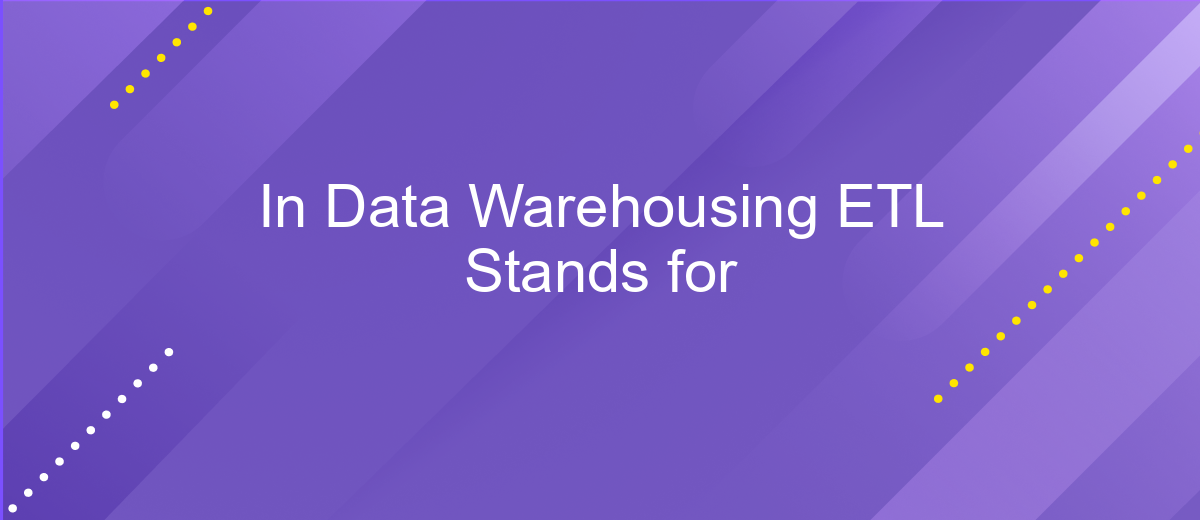In Data Warehousing ETL Stands for
In the realm of data warehousing, ETL stands for Extract, Transform, Load. This crucial process involves extracting data from various sources, transforming it to fit operational needs, and loading it into a data warehouse. ETL is fundamental for consolidating data, ensuring its quality, and making it accessible for analysis and decision-making in businesses.
Introduction
In the realm of data warehousing, ETL stands for Extract, Transform, Load. This process is fundamental for preparing data for analysis and reporting. ETL tools extract data from various sources, transform it into a suitable format, and load it into a data warehouse. This ensures that the data is clean, consistent, and ready for business intelligence applications.
- Extract: Gathering data from multiple sources.
- Transform: Converting data into a usable format.
- Load: Importing data into the data warehouse.
Effective ETL processes are crucial for accurate data analysis. Tools like ApiX-Drive can streamline the integration of various data sources, automating the extraction and loading phases. This reduces manual effort and minimizes errors, ensuring that data is always up-to-date and reliable. By leveraging such services, organizations can focus more on analyzing data rather than managing it.
What ETL Stands For

ETL stands for Extract, Transform, Load. These are the three fundamental steps in the data warehousing process. Extraction involves retrieving raw data from various sources such as databases, APIs, or flat files. This step is crucial as it gathers all the necessary data required for analysis and reporting. Transformation, the second step, involves converting the extracted data into a suitable format or structure. This can include data cleaning, normalization, and enrichment to ensure the data is accurate and useful. Finally, the Load step involves importing the transformed data into a data warehouse or another target system where it can be accessed for business intelligence and analytics.
Modern ETL processes often leverage advanced tools and services to streamline integration and data handling. For instance, ApiX-Drive is a service that facilitates seamless integration between various applications and data sources, automating the extraction and loading processes. By using such services, businesses can significantly reduce the manual effort involved in ETL, ensuring data is consistently up-to-date and readily available for decision-making. This not only enhances operational efficiency but also allows for more accurate and timely insights.
ETL Process

The ETL process is a crucial component in data warehousing, standing for Extract, Transform, and Load. This process involves extracting data from various sources, transforming it into a suitable format, and then loading it into a data warehouse for analysis and reporting. Each step is essential for ensuring data quality and consistency.
- Extract: Data is collected from multiple sources such as databases, APIs, and flat files. This step often involves using connectors and tools to gather the required data efficiently.
- Transform: The extracted data is then cleaned, normalized, and converted into a format suitable for analysis. This may include removing duplicates, correcting errors, and applying business rules.
- Load: Finally, the transformed data is loaded into the target data warehouse. This step ensures that the data is available for querying and reporting purposes.
Tools like ApiX-Drive can significantly simplify the ETL process by providing seamless integrations with various data sources and automating data extraction and loading. This not only saves time but also reduces the risk of errors, ensuring that the data in the warehouse is accurate and up-to-date.
Benefits of ETL

ETL (Extract, Transform, Load) processes are crucial for efficient data warehousing, offering numerous benefits that enhance data management and analysis. By automating data extraction from various sources, ETL ensures consistent and accurate data collection, which is essential for making informed business decisions.
One of the significant advantages of ETL is its ability to transform raw data into a structured format, making it easier to analyze and interpret. This transformation process includes data cleaning, normalization, and integration, which helps in maintaining data quality and consistency across the organization.
- Improved data quality and consistency
- Streamlined data integration from multiple sources
- Enhanced data analysis and reporting capabilities
- Time-saving automation of data processing tasks
- Scalability to handle growing data volumes
Furthermore, services like ApiX-Drive facilitate the integration of various data sources into your ETL workflows. By using ApiX-Drive, organizations can automate data transfers, reducing manual efforts and minimizing the risk of errors. This ensures that the data is always up-to-date and readily available for analysis, ultimately driving better business outcomes.
Challenges of ETL
One of the primary challenges of ETL (Extract, Transform, Load) in data warehousing is dealing with the complexity of data integration from various sources. Data can come in different formats, structures, and quality, making it difficult to standardize and cleanse before loading it into the data warehouse. This process often requires significant time and resources to ensure data accuracy and consistency, which can be a bottleneck for organizations aiming to make data-driven decisions quickly.
Another significant challenge is the scalability of ETL processes. As data volumes grow, the ETL infrastructure must be able to handle increased loads without compromising performance. This scalability issue can be particularly problematic for businesses experiencing rapid growth or dealing with large datasets. Tools like ApiX-Drive can help mitigate these challenges by providing automated data integration solutions that simplify the process of connecting various data sources, thus reducing the manual effort required and ensuring more efficient data processing.
FAQ
What does ETL stand for in Data Warehousing?
Why is ETL important in Data Warehousing?
What are the main steps involved in the ETL process?
How often should the ETL process be run?
Can ETL processes be automated?
Apix-Drive is a universal tool that will quickly streamline any workflow, freeing you from routine and possible financial losses. Try ApiX-Drive in action and see how useful it is for you personally. In the meantime, when you are setting up connections between systems, think about where you are investing your free time, because now you will have much more of it.

